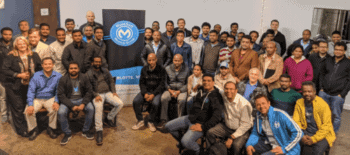In times of struggle, I’ve always been of the mind to try and help those in need. And in today’s world, my first thought is to look toward technology and the ways it can assist users in simplifying tasks, or making sense of information. To see what we could create around healthcare datasets, a few innovative members of the Silverline team — Connor Jerrow, Derek Bransford, and I — got together for a small hackathon.
Covid-19 is an example of a large data set relevant for today’s state of affairs, that is also publicly accessible, so that’s what our team used as a sample.
As American businesses begin to reopen, they will be challenged with a new reality. Consumers have valid concerns about re-engaging with the world outside of their homes. For businesses that leverage Salesforce for patient engagement, reestablishing a connection and alleviating consumer fears will be top of mind. The ability to have relevant, real-time data at an agent’s fingertips will go a long way toward regaining trust and building a deeper connection with consumers.
Now and in the future, there are certain to be meaningful conversations between patients and providers, discussing the challenges in their communities. To ensure the right approach is leveraged, and the right messaging meets the needs of the different demographics, it will be important that organizations have the right information for their interactions.
But how? With improved data integration.
Let’s have a hackathon
We approached the working session with the belief that individuals affected by Covid-19 should receive high-quality support, and experience an improved feeling of connection with the companies that they rely on for services.
Working outside of normal project hours, and leveraging the Salesforce platform, we created a tool that when deployed, allows companies to connect with their prospects and customers to improve the quality of human interaction.
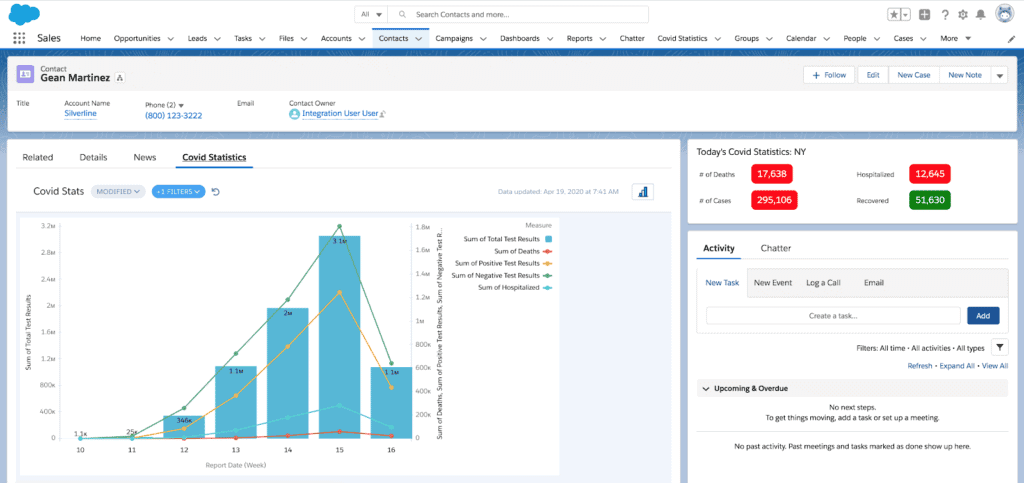
Sample data populates the tool created
Users can navigate to a specific customer and get real-time updates about how their state has been impacted. On the far right, they can see the day’s stats for the state.
While we used Covid-19 data as our model, this newly created capability can easily incorporate healthcare data sets such as influenza season heat maps, social determinants of health by zip code, and immunization/testing locations by zip code.
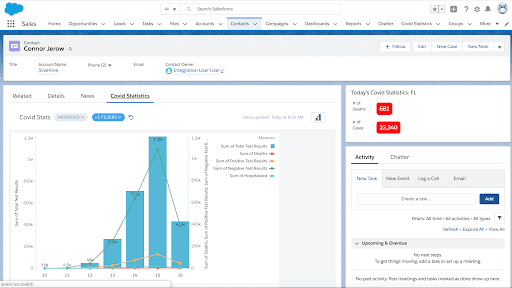
Previous Covid-19 Statistics for the state of Florida
On the newly present Covid Statistics Lightning Component Tab, users can see historical trends of total cases, hospitalizations, deaths and test results. This can inform users on how Covid-19 is trending in the customer’s state and understand what the customer has likely faced in the past.
Integrating data, one piece at a time
For the stats and numbers, we leverage APIs and data from The COVID Tracking Project, which collects and publishes the most complete Coronavirus testing data available for US states and territories. But let’s talk about how we made it all come together.
System Architecture
For the Solution Architecture, we leveraged Salesforce Health Cloud, which has various capabilities relevant to our use case — such as prospect nurturing, customer service, and statistics analysis. In addition, we leverage Einstein Analytics (EA) and a dataflow to move data from Salesforce to EA. Finally, we use the MuleSoft platform to power the integrations and APIs as depicted in the architecture diagram below.
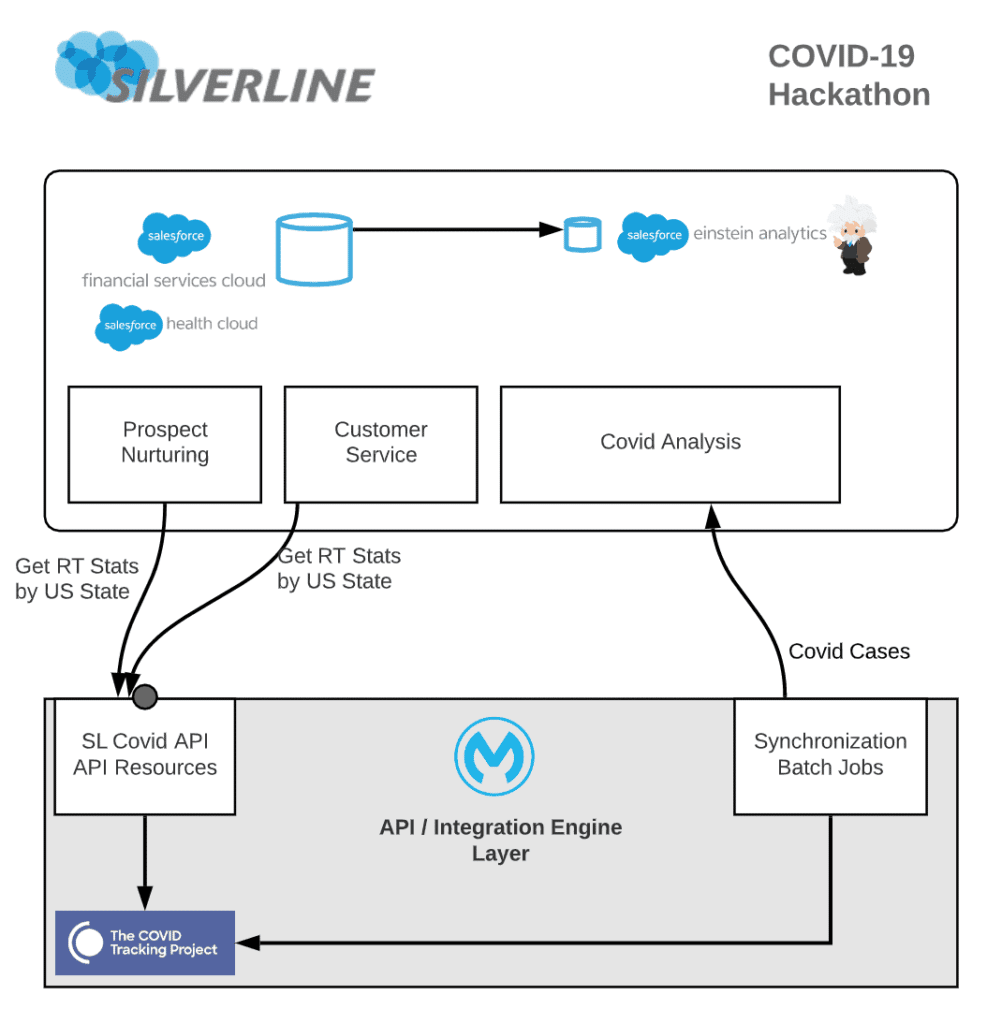
The Covid_Statistics__c Custom sObject
Our team set up a custom object with the relevant fields we wanted to populate for our integration.
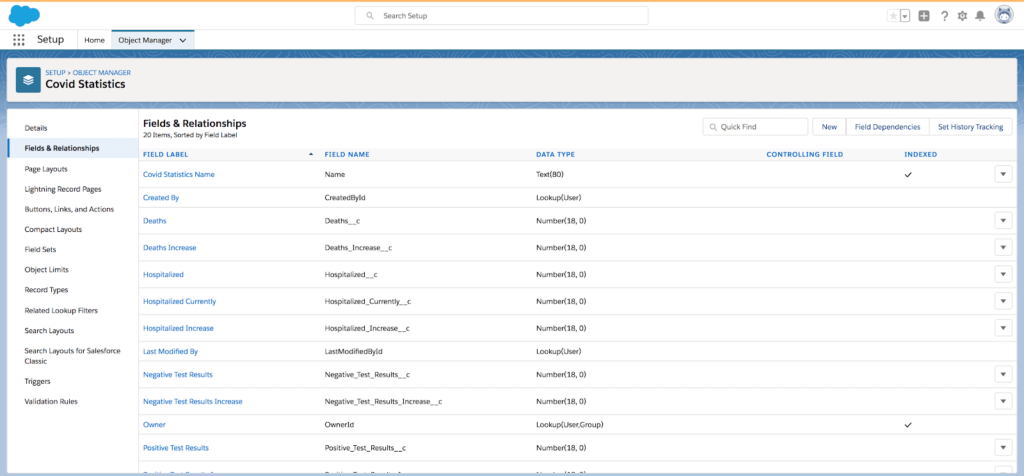
Einstein Analytics
Our team set out to create Einstein Analytics (EA) lenses and dashboards. We did so by creating a data flow that reads data integrated from our Covid_Statistics__c object and Contact objects and then registers a covidStats dataset. This is EA’s data manager flow editor where we register various datasets.

Dashboard showcasing historical data integrated from The COVID Tracking Project
Silverline built a COVID ANALYSIS – USA dashboard with historical data integrated from The COVID Tracking Project and can now see the impact of testing, negative and positive results as well as deaths for the entire United States.
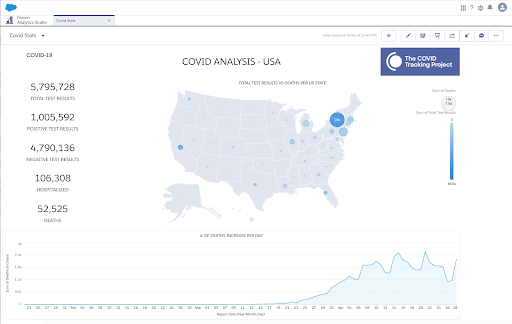
Testing results for entirety of the United States
With Einstein Analytics drill-down capabilities, we can take a closer look at any state.For example, we can look at all testing data for California.
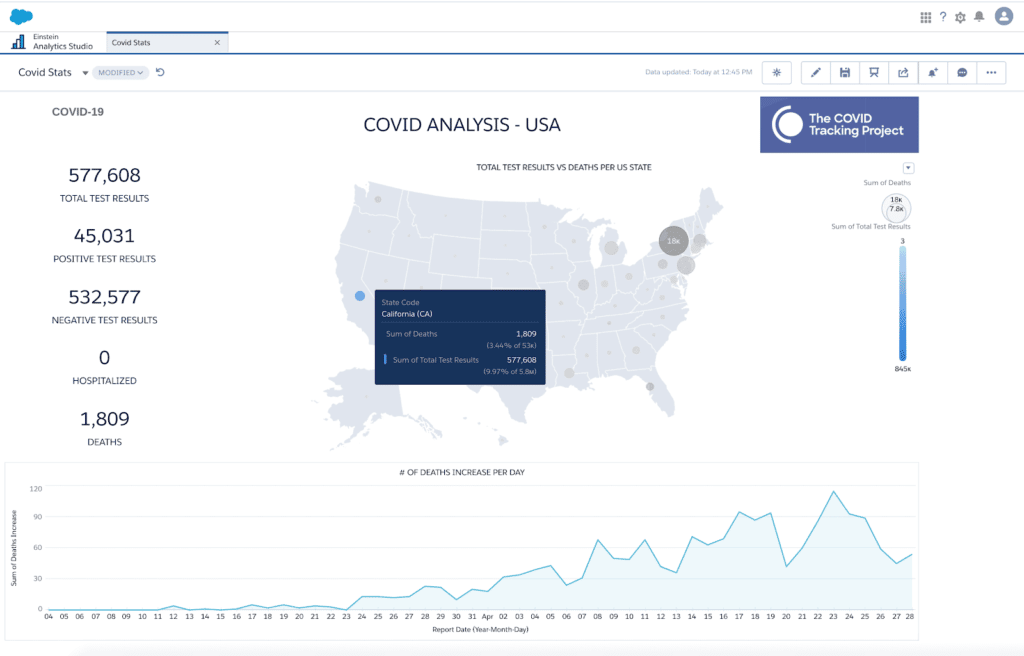
Testing results for the state of California
Lightning components
Jerrow focused on Lightning components in order to provide the most up-to-date information to Salesforce users, which in turn enables them to better understand their contacts’ Covid-19 situation. And by doing so, we can display current statistics with a custom user interface.
By leveraging Lightning Web Components (LWC), we can visualize real-time Covid-19 statistics for a given state. The main LWC is configured to take State Code as an API parameter. When the State Code is provided, the LWC makes a callout to an Apex Controller, which then reaches out to the Mulesoft real-time endpoint.
While the main LWC is currently used on the Contact record page because it is configured to take a State Code, we can leverage it on any record that has an address or even by passing a configured static state code on any Lightning page.The fields are laid out with a data-configured LWC form, lightningForm, and styled using trendField, both of which are open source assets.

Lightning Component as rendered on a page, with statistics for a given US State/day
Note: This lightning component can be leveraged in any Salesforce Lightning experience including Salesforce Lightning Communities.
MuleSoft Architecture
For the integrations, we needed historical data and the ability to get real-time updates. We quickly settled on MuleSoft to get us the data integration we needed because of the connectors and templates already provided for Salesforce. In MuleSoft, Bransford built the Covid-19 API as a Process API so that we could access the data we needed then but could also easily orchestrate data aggregated from multiple systems in the future. For the Covid Historical Batch Process Application, we used the Salesforce connector in MuleSoft, which allowed us to easily sync the integrated historical data to Salesforce with minimal configuration. Further expansions may include an Experience API for a mobile application that would be tailored to the security and utilization needs for a mobile solution.
This API Led Connectivity diagram illustrates how we structure the APIs and integration apps across the three different API Led layers.
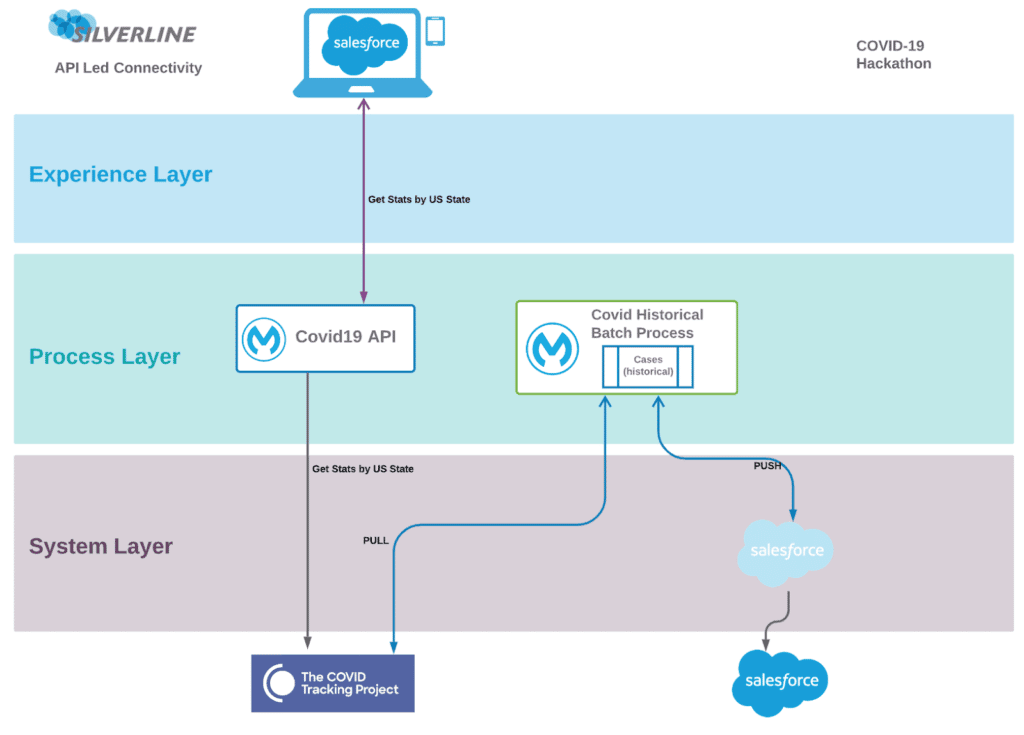
Anypoint Studio Flow
By employing the pre-built migration templates for Salesforce in MuleSoft’s Exchange we successfully created a functioning Mule app within a matter of hours to sync the integrated data to Salesforce. To make sure we had quality logs, we used the open source JSON logger to standardize our logging strategy for our MuleSoft project. The image below shows that the two flows are straightforward and each component to the appt has a meaningful name to help other users understand the purpose of each component.
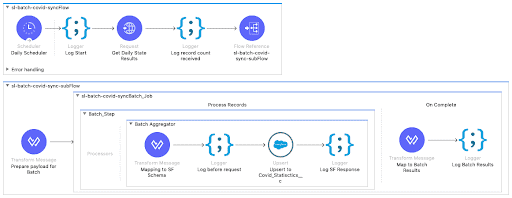
Anypoint Studio batch application flows to sync historical state results
API Design using RAML
For real-time updates in Salesforce, we exposed a MuleSoft API that returns the latest data by US State. Using MuleSoft’s API Specification language RAML we quickly created a definition, and provided a mock endpoint to our Salesforce Devs so they could build their components while the API implementation was built in parallel.
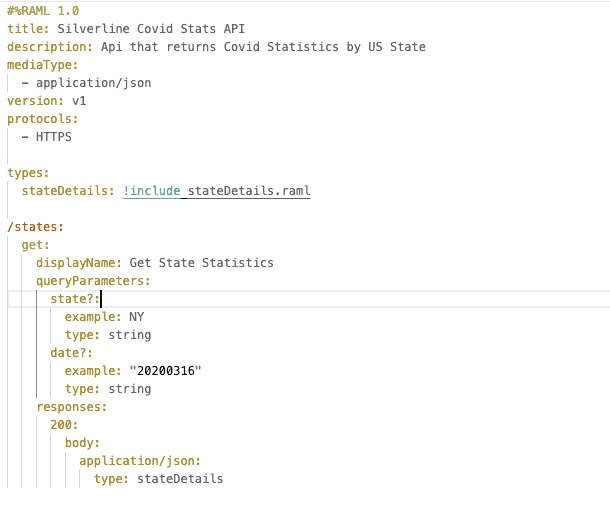
RAML API specification to get up-to-date statistics by state
Application Network
Now that we have both a daily sync of data and real-time capabilities let’s look at our applications in Anypoint Platform’s Visualizer. As shown below, our Mule API and batch application and the systems of interaction. Visualizer provides you a view of your application network and basic information about your applications. The visual created resembles our initial architecture diagram, so we know that what we built represents the vision of the project.
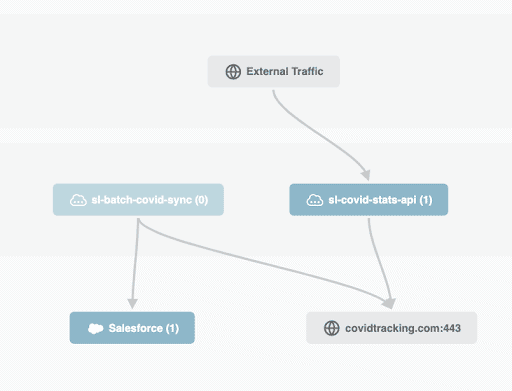
Data Source Agnostic
By leveraging MuleSoft, we successfully abstracted the dependency on the COVID Tracking Project data source and can plug other data sources to replace The COVID Tracking Project or augment it with other integrated data sources. By following an API-led approach, you can swap out the systems in play with other systems, as shown below.
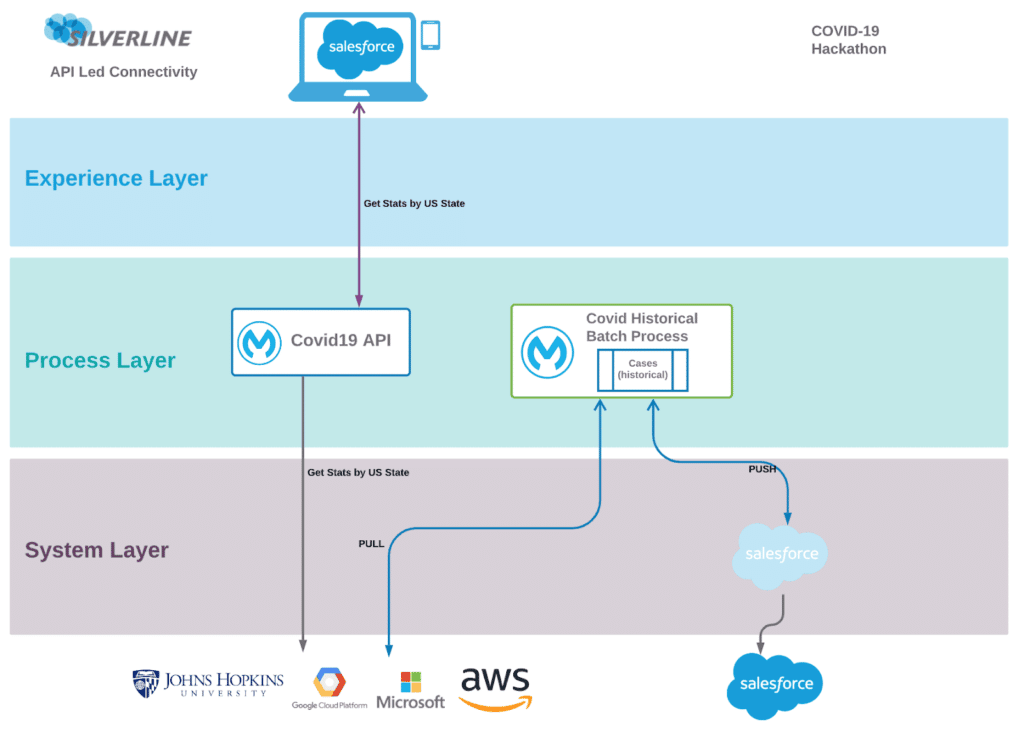
With this Covid-19-related hackathon, we leveraged the best cloud-based, integrated CRM platform in Salesforce, its modern and extensible user interface component framework with Lightning, a leading business intelligence platform in Einstein Analytics, and a robust connectivity platform for APIs and integration in MuleSoft. While in practice we used Covid-19 data, in production, this tool can easily incorporate large sets of regional healthcare data to aid in understanding and supporting patient and member needs.
Innovating as we go
Silverline’s team of architects, developers and analysts will occasionally swarm around business and technology challenges and engage in hackathons. Together we aim to tap into the creativity, curiosity, and perspective of each individual involved and we strive to leverage the best technology that will help solve for the target use cases.
This type of innovation is the value that Silverline can add to your organization that ultimately benefits your customers, members or patients. This is just one example of the kind of concepts, tools, and solutions we create up with when our teams come together to solve problems.
Are you ready to view your data in a new way? Reach out to see what we can build for you.




